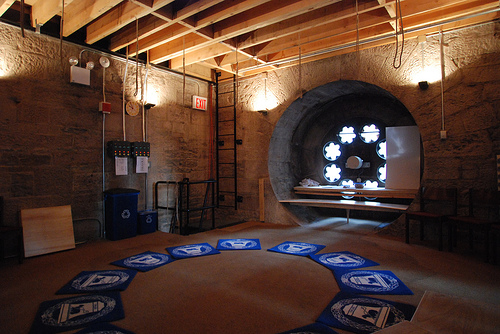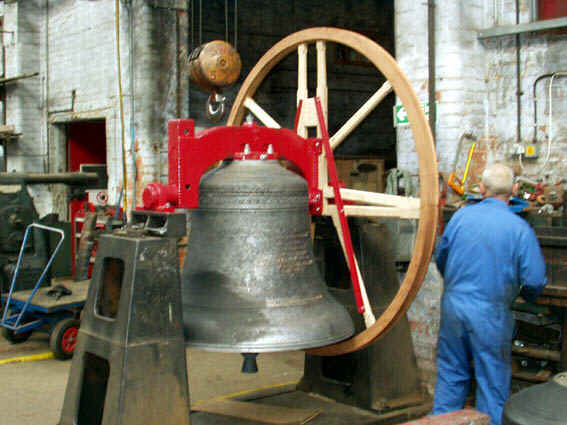AGM @ Trinity
This past week, Trinity Church (previous post) hosted the AGM.
As a result, the NY Times wrote an article about the event and change ringing.
Neat, I just found out that the ringers at Trinity have a new website.
This past week, Trinity Church (previous post) hosted the AGM.
As a result, the NY Times wrote an article about the event and change ringing.
Neat, I just found out that the ringers at Trinity have a new website.
This past Monday, it was a year since I was introduced to a very interesting (and a very English) activity — change ringing. Wikipedia’s  article has a good summary:
article has a good summary:
Change ringing is the art of ringing a set of tuned bells in a series of mathematical patterns called “changes”. It differs from many other forms of campanology (such as carillon ringing) in that no attempt is made to produce a conventional melody.
Trinity was the first bell tower set up for change ringing that I went to (I think there are about 40 or 50 in all of North America). The bell tower is part of the Trinity church on the intersection of Broadway and Wall St in NYC. Here’s a link that has information about the bells at Trinity. I’ll probably include most of it here, as well as “borrow” some of the photos. (If I don’t say where I got a particular photo, it’s because I took it myself.)
I tried taking a photo of the church further down the street, but it didn’t go all that well (it was late afternoon, so the church walls were in a shadow, and the sky behind it was bright). So, here’s someone else’s photo that’s from the same perspective as the one I was trying to make:

Trinity is one of only two towers in North America that has 12 bells (the other is St. James’ Cathedral in Toronto). All the other towers in North America have less (8 bells being the most common). The practice of change ringing is originally from England, and there 12 bells is pretty normal.
These are the “specs” for the Trinity bells (all cast by Taylors, Eayre & Smith in 2006):
| Bell | Weight | Diameter | Note |
| Treble | 4-2-11 | 25 9/16” | A |
| 2 | 5-0-5 | 26 5/8” | G |
| 3 | 4-3-9 | 26 3/4” | F# |
| 4 | 5-0-1 | 28” | E |
| 5 | 5-1-23 | 29 3/8” | D |
| 6 | 5-3-14 | 30 5/8” | C# |
| 7 | 6-2-24 | 32 1/2” | B |
| 8 | 7-3-16 | 34 7/8” | A |
| 9 | 9-2-10 | 37 7/8” | G |
| 10 | 12-1-21 | 41 1/8” | F# |
| 11 | 16-3-9 | 45 1/2” | E |
| Tenor | 23-3-17 | 51” | D |
The weight is represented by a triple of numbers. The first is the number of  hundredweights (1 cwt = 112lbs = approx. 50kg); the second number is the number of quarters (0.25 cwt = 28lbs = 12.7kg); and the third number is the number of pounds (1lb = 0.454kg). So, for example, the tenor is 2677lbs = 1214kg (23*112 + 3*28 + 17 = 2677).
hundredweights (1 cwt = 112lbs = approx. 50kg); the second number is the number of quarters (0.25 cwt = 28lbs = 12.7kg); and the third number is the number of pounds (1lb = 0.454kg). So, for example, the tenor is 2677lbs = 1214kg (23*112 + 3*28 + 17 = 2677).
For comparison, the  Liberty Bell (as recast by Pass and Stowe in 1753) is 18-2-8 (2080 lbs; 943 kg).
Liberty Bell (as recast by Pass and Stowe in 1753) is 18-2-8 (2080 lbs; 943 kg).
Alright, let’s head upstairs into the ringing room. (photo taken from flick).

Inside the tower, the ropes to control 12 bells (or however many a change ringing tower may have) are arranged in a circle, so that if a person stands near each rope, they can see all the other ropes easily.
This is what the Trinity ringing room looks like (also taken from flickr):

You can see the ropes hanging from the ceiling. They are at the back-stroke (more on this later), therefore you can’t see much of them.
Each rope goes though the ceiling, to a wooden wheel that’s affixed to the bell. The whole assembly looks like (this is the tenor from Trinity while still at the foundry):

You can easily see the wheel, and the (red) headstock. When a person pulls on the rope, it turns the wheel, which in turn moves the bell.
Anyway, that’s it for the introduction to the Trinity Church bell tower. You’ll have to wait for the next post to learn more about change ringing itself. :P
Powered by blahgd